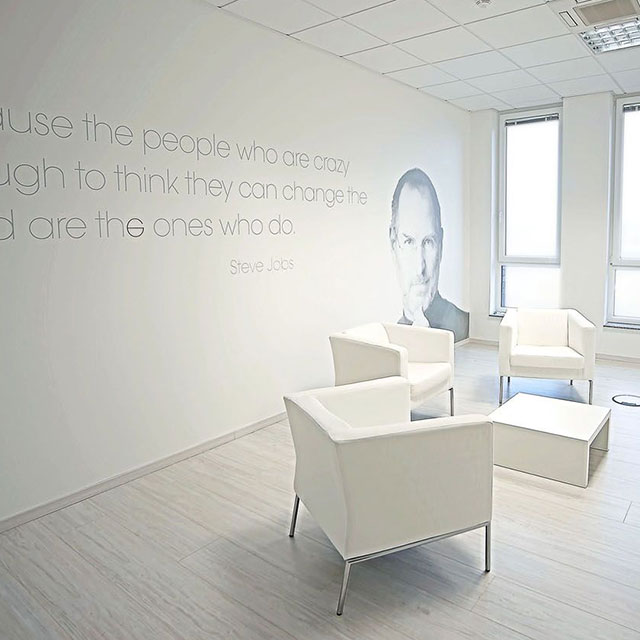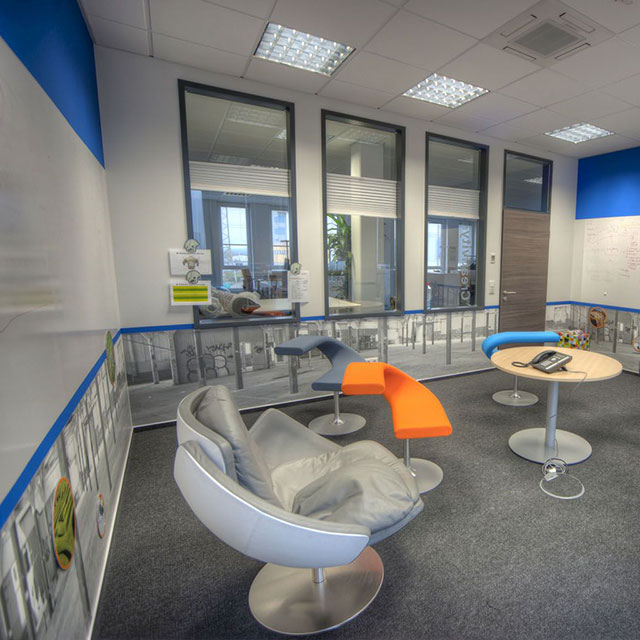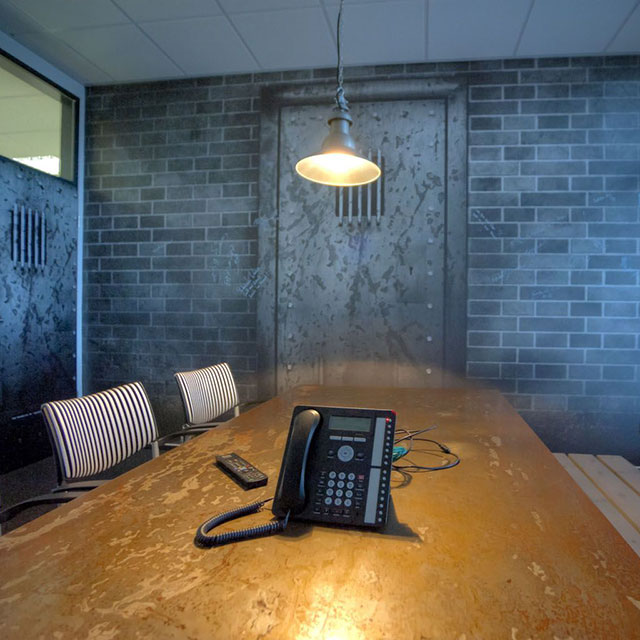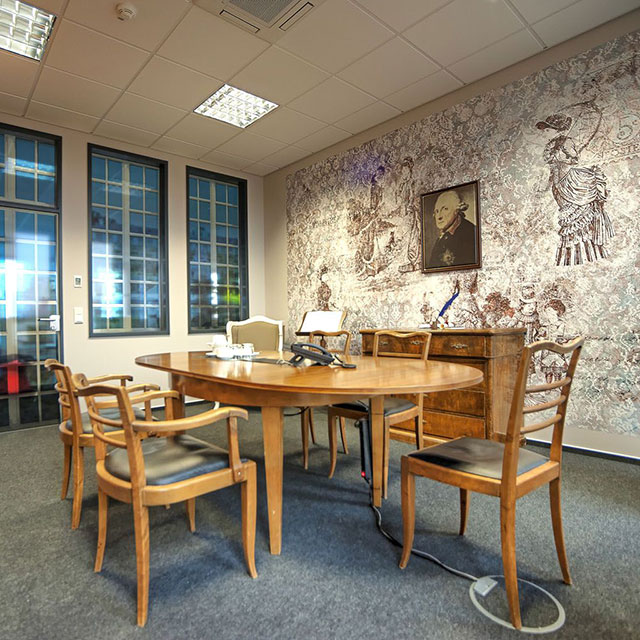Special spaces of experience
As the PPP (Public Private Partnership) company LH Dienstbekleidungs GmbH (Service Apparel) began to acquire private companies around the world, many different corporate cultures came together. CEO Axel Nagel was faced with the question: “What would it take for us all to grow faster?” Nagel realized that ingenuity was required to ensure fast convergence and the development of the creative potential of the workforce, in particular at the new headquarters in Cologne. This was an essential prerequisite to remain competitive throughout the phase of the post-merger integration. He resorted to unusual measures to strengthen personal contact between employees as well as their creativity.
The history of today’s LHD Group began in 2002 when then-Defense Minister Rudolf Scharping privatized the clothing industry of the Bundeswehr (Army). In the course of this privatizing, two internationally active family companies (Hellmann Worldwide Logistics and Lion Apparel) started—with the Department of Defence—the LH Bundeswehr Clothing Company (LHBw). The federal government holds a minority share of 25.1 percent. It was a requirement for the establishment of the company that the public-private partnership should do business irrespective of Bundeswehr orders in the medium term. To build additional business and to ensure transparency in financial and commodity streams, LHBw founded the subsidiary LHD. This subsidiary equips with work wear clients such as Lufthansa, BASF, the ADAC or fire departments, and the police of several countries.
THE ROAD TO S SHARED FUTURE
In 2008, the LHD acquired the privately owned Swiss company as AG and, some time later, the international distribution companies of the 110-year-old traditional company LION Apparel. This enabled the company to conquer other European—as well as Asian-Pacific and Middle Eastern—markets. However, it also had to face all those different corporate cultures. The challenge was to get employees together as soon as possible to work for one common goal.
This step was crucial. Initially, the cultures of LHBw and LHD were strongly influenced by their original primary customer, the Bundeswehr. To enhance the convergence and further the joint development of the newly formed group of companies, Axel Nagel decided on two things. First, the central functions of the group should be pulled together under one roof. Second, the new home of the workforce should be designed in a way that makes it easy for employees to get in touch with one another. The idea behind it was to link together all existing knowledge and use it for productivity.
“An employer must provide opportunities so that a more personal and inspiring exchange can take place,” summarizes the chief mediator of the almost 1,700-people-strong group of companies. “Accordingly, we achieve better access to the creative potential of our workforce. That’s why we need to remain innovative.”
SPACE FOR COLLECTIVE CREATIVITY
This vision found its implementation in a remarkable building. At the gates of Cologne, in direct proximity to the airport, LHD built a multi-story building flooded with light. They used a very unique design concept which actively engages management, the project team, the marketing department, and all employees. The aim was to create a world of experience—an enjoyable workplace in which every guest has the opportunity to experience the multi-faceted, open culture of LHD on a sensual level.
The center of the building is marked by generous open-space areas. There is also a range of themed rooms which give the visitor the feeling of entering an entirely different world. Each themed room combines tangible and intangible corporate concepts. For example, there is one room modeled after the library of Frederick the Great and decorated with furniture from the 18th century. This space represents the values of the company, shows the tradition, and has the atmosphere of a “parlour.” It’s a room where difficult conversations as well as in-depth individual or group work can take place—and all that in a very benevolent frame.
With this building design, you can find a suitable room for every need. Another room is reminiscent of an oversized aquarium, while another room is designed like a prison cell. A total of 14 themed rooms are distributed throughout the four-story building with its three-meter-high ceilings. For each of the major product groups of the company, there is at least one room. The service philosophy, geographical market areas, and individual customer groups were also taken into account for inspiration and design concepts.
Whoever wants to let his imagination run wild can do so in a room whose walls are coated so that employees can write or even draw on them. For employees who want to bring their children, there is a separate room with a desk for the adults and toys for the little ones. The gleaming white Think-Different Room offers exclusive inspiration. It displays a larger-than-life photo of the legendary entrepreneur Steve Jobs.
In the middle of the building, on three of the four floors, you can find areas where all employees can meet whenever they want, not just during breaks. CI merges here with country themes of LHD with a café-like atmosphere. On another floor, you can find a kitchen for employees to prepare their own food if they so wish. In another hall, there is a café in an Arabian style with specially imported traditional Berber materials from Dubai. On the top floor, you will find a room with three large red sofas. That’s the place where the bosses come together with their iPads to answer outstanding emails but also to be accessible to employees.
CONTEMPLATION AND MEETING-ROOMS
Many employees regularly migrate across the building to spend time in one of the themed rooms during work hours, either alone or in teams. Thanks to the unusual visual stimuli, it is easier for them to get out of their work routines and give their ideas new direction. In addition, staff from different departments meet and blend with each other. “Move and encounter” is the simple motto, which is supposed to promote productivity and health.
“If you go through the house, you can hardly tell which employees belong to which groups of our company,” says marketing manager Katharina Heiser. “Immediately after the acquisitions you could strongly feel the differences in cultures. Now the openness of the environment automatically carries over to the people.”
The idea of creating an office so playful and multifaceted that there is always something new to be discovered is bearing fruit. The processing time of orders and projects has already reduced by more than 20 percent. The necessary innovations to stay ahead of the completion will not cease.
However, not every employee can deal with this new corporate culture. Over the last five years, CEO Nagel estimates, he has lost approximately five percent of the workforce due to this cultural change. Consequently, he looked through all the personal files, searching for hidden talents. For example, six years ago, when he started as head of the department as the process of change started, he had a marketing manager. However, she had only a temporary job in the Quality Assurance Department. Her communication and marketing knowledge were needed. Therefore, he gave her the chance to build the marketing area. “Every time an employee furthers himself, it increases the value of our company,” says Axel Nagel. He sees the unique architecture of the building and the holistic design as another form of investment in the intangible assets of the firm: the mental skills of its employees.
We like the approach of the company because employees are invited to leave recurrent structures. New approaches are made possible through the multi-faceted theme rooms and their particular environment. More importantly, the intense and highly interpersonal contact is supported by architecture and design, thus complying with the neurobiological need for connectedness.



